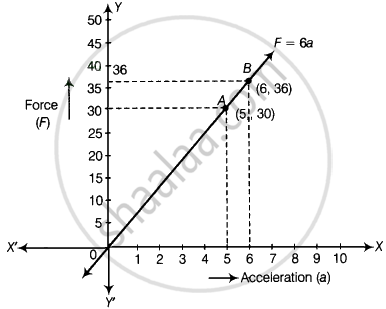Advertisements
Advertisements
Question
The force exerted to pull a cart is directly proportional to the acceleration produced in the body. Express the statement as a linear equation of two variables and draw the graph of the same by taking the constant mass equal to 6 kg. Read from the graph, the force required when the acceleration produced is (i) 5 m/sec2, (ii) 6 m/sec2.
Solution
Given that, the force (F) is directly proportional to the acceleration (a).
i.e., F ∞ a
⇒ F = ma ...[Where, m = arbitrary constant and take value 6 kg of mass]
∴ F = 6a ...(i)
(i) If a 5 m/s2, then from equation (i), we get
F = 6 × 5 = 30 N
(ii) If a 6 m/s2, then from equation (i), we get
F = 6 × 6 = 36 N
Here, we find two points A(5, 30) and B(6, 36).
So draw the graph by plotting the points and joining the line AB.

APPEARS IN
RELATED QUESTIONS
Draw the graph of the following linear equation in two variable : ` x / 2 - y/ 3 = 2`
Draw the graph of the equatio ` x / y + y /4 = 1` Also, find the area of the triangle formed by the
line and the co-ordinates axes.
Draw the graph of y = | x | + 2.
Draw the graph for the equation, given below :
3x + 2y = 6
Draw the graph for the equation given below; hence find the co-ordinates of the points where the graph is drawn meets the co-ordinates axes:
`(2x + 15)/(3) = y - 1`
Use the given table and draw the graph of a straight line.
| X | 1 | 2 | 3 | P |
| Y | 1 | q | -5 | 7 |
Find graphically the values of 'p' and 'q'.
Draw the graph of the following equation:
x = – 7
Draw the graph of y = 2x + 5
The graph of every linear equation in two variables need not be a line.
If the point (3, 4) lies on the graph of 3y = ax + 7, then find the value of a.
